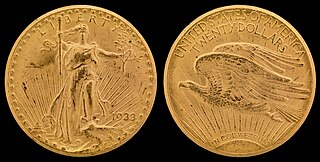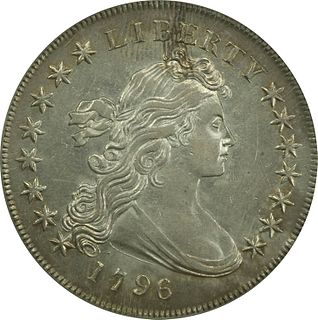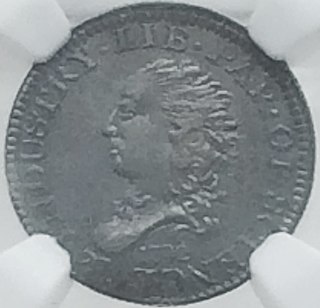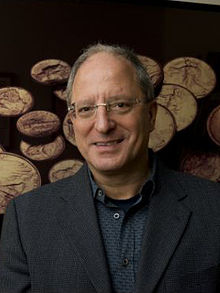
A nickel is a five-cent coin struck by the United States Mint. Composed of 75% copper and 25% nickel, the piece has been issued since 1866. Its diameter is 0.835 inches (21.21 mm) and its thickness is 0.077 inches (1.95 mm). Due to inflation, the purchasing power of the nickel continues to drop, and currently the coin represents less than 1% of the federal hourly minimum wage. In 2018, over 1.26 billion nickels were produced at the Philadelphia and Denver mints.

The 1933 double eagle is a United States 20-dollar gold coin. Although 445,500 specimens of this Saint-Gaudens double eagle were minted in 1933, none were ever officially circulated, and all but two were ordered to be melted down. However, 20 more are known to have been rescued from melting by being stolen and found their way into the hands of collectors before later being recovered. Nine of the recovered coins were destroyed, making this one of the world's rarest coins, with only 13 known specimens remaining—only one of which is privately owned.

The Eisenhower dollar was a one-dollar coin issued by the United States Mint from 1971 to 1978; it was the first coin of that denomination issued by the Mint since the Peace dollar series ended in 1935. The coin depicts President Dwight D. Eisenhower on the obverse, and a stylized image honoring the 1969 Apollo 11 Moon mission on the reverse, with both sides designed by Frank Gasparro. It is the only large-size U.S. dollar coin whose circulation strikes contained no silver.

The Draped Bust dollar is a United States dollar coin minted from 1795 to 1803, and was reproduced, dated 1804, into the 1850s. The design succeeded the Flowing Hair dollar, which began mintage in 1794 and was the first silver dollar struck by the United States Mint. The designer is unknown, though the distinction is usually credited to artist Gilbert Stuart. The model is also unknown, though Ann Willing Bingham has been suggested.

The Flowing Hair dollar was the first dollar coin issued by the United States federal government. The coin was minted in 1794 and 1795; its size and weight were based on the Spanish dollar, which was popular in trade throughout the Americas.

The 1913 Liberty Head nickel is an American five-cent piece which was produced in extremely limited quantities unauthorized by the United States Mint, making it one of the best-known and most coveted rarities in American numismatics. In 1972, one specimen of the five cent coin became the first coin to sell for over US$100,000; in 1996, another specimen became the first to sell for over US$1 million. In 2003, one coin was sold for under three million dollars. In 2010, the Olsen piece sold for US$3.7 million at a public auction.

The 1792 half disme is an American silver coin with a face value of five cents which was minted in 1792. Although it is subject to debate as to whether this was intended to be circulating coinage or instead an experimental issue, President George Washington referred to it as "a small beginning" and many of the coins eventually were released into circulation. It is widely considered the first United States coinage struck under authority of the Coinage Act of 1792.

The Oregon Trail Memorial half dollar was a fifty-cent piece struck intermittently by the United States Bureau of the Mint between 1926 and 1939. The coin was designed by Laura Gardin Fraser and James Earle Fraser, and commemorates those who traveled the Oregon Trail and settled the Pacific Coast of the United States in the mid-19th century. Struck over a lengthy period in small numbers per year, the many varieties produced came to be considered a ripoff by coin collectors, and led to the end, for the time, of the commemorative coin series.

The Brasher Doubloon is a rare American coin, privately minted in and after 1787.

The Columbian half dollar is a coin issued by the Bureau of the Mint in 1892 and 1893. The first traditional United States commemorative coin, it was issued both to raise funds for the 1893 World's Columbian Exposition and to mark the quadricentennial of the first voyage to the Americas of Christopher Columbus, whose portrait it bears. The Columbian half dollar was the first American coin to depict a historical person.
Rare Coin Wholesalers is a rare-coin company that specializes in United States rare coins. Located in Irvine, California, Rare Coin Wholesalers buys, sells, appraises and trades rare coins and precious metals. Originally established as a S.L. Contursi company in 1990, the owners have bought and sold over two billion dollars' worth of rare coins.

The National Numismatic Collection is the national coin cabinet of the United States. The collection is part of the Smithsonian Institution's National Museum of American History.

The Turban Head eagle, also known as the Capped Bust eagle, was a ten-dollar gold piece, or eagle, struck by the United States Mint from 1795 to 1804. The piece was designed by Robert Scot, and was the first in the eagle series, which continued until the Mint ceased striking gold coins for circulation in 1933. The common name is a misnomer; Liberty does not wear a turban but a cap, believed by some to be a pileus or Phrygian cap : her hair twisting around the headgear makes it resemble a turban.

Michael "Miles" Standish is an American businessman, author, rare coin expert, sports memorabilia expert and philanthropist. He is co-founder of Collectors Universe. He currently serves as vice president of the Numismatic Guaranty Corporation (NGC).
Flowing Hair coinage was issued in the United States between 1793 and 1795. The design was used for the first half dime, half dollar, dollar, and the first two large cents.

The McKinley Birthplace Memorial gold dollar was a commemorative coin struck by the United States Bureau of the Mint in 1916 and 1917, depicting the 25th President of the United States, William McKinley. The coin's obverse was designed by Charles E. Barber, Chief Engraver of the Mint, and the reverse by his assistant, George T. Morgan. As McKinley had appeared on a version of the 1903-dated Louisiana Purchase Exposition dollar, the 1916 release made him the first person to appear on two issues of U.S. coins.

The 1804 dollar or Bowed Liberty Dollar was a dollar coin struck by the Mint of the United States, of which fifteen specimens are currently known to exist. Though dated 1804, none were struck in that year; all were minted in the 1830s or later. They were first created for use in special proof coin sets used as diplomatic gifts during Edmund Roberts' trips to Siam and Muscat.

The Wisconsin Territorial Centennial half dollar was designed by David Parsons and Benjamin Hawkins and minted in 1936. The obverse depicts a badger and the territorial seal, while the reverse shows a pick axe and lead ore.
Blanchard and Company, Inc. is an investment firm specializing in rare coins and precious metals, including gold bars, silver coins and bars, platinum, and palladium.
















